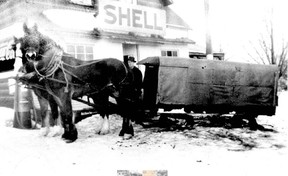Article content
By Robin Hilborn
Bruce County Historical Society
Advertisement 2
Article content
The mail must go through, they say – through snow and rain and gloom of night. Even if it means walking 45 miles, and back.
In 1852, that was the job of Cowan Keys, the first mail carrier of Bruce County. With Her Majesty’s mail in a satchel slung over his shoulder he would tramp once a week over the rough trail between Kincardine and Durham.
Another postal route ran from Kincardine to Southampton. Mailman John Urquhart walked this route twice a week.
With the opening of the railway to Goderich in 1858, the Royal Mail arrived daily in Kincardine, carried on horseback. The inhabitants of Kincardine had the luxury of getting Toronto newspapers which were only one day old. Other parts of the county waited for years for daily mail.
Advertisement 3
Article content
The next improvement—when the trail was cleared of tree stumps—was the horse-drawn stagecoach. It offered daily service to the more populated areas of Bruce County. The bumpy ride was alleviated by stops at roadside taverns and hotels, which provided stabling for the horses.
Sometimes the stage got stuck in mud or in a swamp, so drivers welcomed the introduction of the gravel road. For a long time only the Goderich Road, from Goderich to Southampton, had a gravelled surface, and so was called The Gravel Road.
The Kincardine-Walkerton stage line carried mail for over 50 years before being closed in 1914, when free rural mail delivery replaced the old mail routes.
It was the same for the Port Elgin to Owen Sound stagecoach, put out of business when the rural mail system started in 1913 on that route.
Advertisement 4
Article content
Further north, the Bruce Peninsula was served by stagecoaches, with Wiarton getting daily mail starting in 1876, by way of a coach from Owen Sound.
The first train to Wiarton, in 1881, replaced the stagecoach, but since the tracks ended there, a stagecoach took the mail to points further north.
The Stokes Bay Royal Mail coach took two days to make a round trip from Wiarton, serving Mar, Pike Bay, Spry and Stokes Bay. During the winter months the coach was converted into a sleigh.
We have the envelope of a registered letter showing how mail from Spry reached Hamilton. It was postmarked Feb. 27, 1911, took the Stokes Bay mail coach, reached Wiarton on March 1, left on the train on March 2, was sorted on board in the Railway Post Office in one of the coaches, and reached Hamilton the same day.
Advertisement 5
Article content
In 1881 Stokes Bay post-office was established, where Wm. Lyons was first postmaster, succeeded by John Gibson and John Shute, who held the office for 23 years. The Tobermory post office also opened in 1881, but there the mail was carried by Benjamin Butchart, who hiked in from Stokes Bay.
Another stage line serving the peninsula was the North Kepple-Kemble mail coach, running up the east shore between Owen Sound and Wiarton. Ray West drove this coach until 1947, including in winter, when it was converted into a sleigh.
We can also mention the Wiarton to Lion’s Head stagecoach, with daily stops at the post offices in Colpoy’s Bay, Hope Bay and Barrow Bay. This stage took passengers, and those who might be stranded in the depths of winter were given a hot meal and a warm bed at the house of the Hepburn’s of Hope Bay, who kept the post office there for over 40 years.
Advertisement 6
Article content
Stage routes allowed rural mail delivery to start in 1908. When rural mail was extended to all main roads in 1912 roadside mailboxes became a permanent feature of the countryside.
Business mail has greatly changed since then, and a transaction which used to take a week now occurs in a minute over the internet.
This account draws from Gus Knierim’s “The Conveyance of the Royal Mail in the Bruce,” in the March 1999 newsletter of the Postal History Society of Canada.
Authors are featured at Local Authors Night (with wine and cheese) on Aug. 12, 2024, 7 p.m., in the Bruce County Museum Theatre in Southampton. Scarlett Janusas will talk about the Tobermory wireless station, plus Dr. John Carter on editing the Rebellion issue of “Ontario History” magazine, and David Pyper on his book “The History of Sauble Beach”.

Article content
Source link



